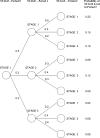Patterns of recovery from severe mental illness: a pilot study of outcomes
- PMID: 19551505
- PMCID: PMC2852027
- DOI: 10.1007/s10597-009-9211-x
Patterns of recovery from severe mental illness: a pilot study of outcomes
Abstract
We performed a pilot study examining the patterns of recovery from severe mental illness in a model integrated service delivery system using measures from the Milestones of Recovery Scale (MORS), a valid and reliable measure of recovery outcomes which ranges from 1 to 8 (8 levels). For purposes of presentation, we constructed an aggregate MORS (6 levels) where the levels are described as follows: (1) extreme risk; (2) unengaged, poorly self-coordinating; (3) engaged, poorly self-coordinating; (4) coping and rehabilitating; (5) early recovery, and (6) self reliant. We analyzed MORS data on individuals followed over time from The Village in Long Beach, California (658 observations). Using Markov Chains, we estimated origin-destination transition probabilities, simulating recovery outcomes for 100 months. Our models suggest that after 12 months only 8% of "extreme risk" clients remain such. Over 40% have moved to "engaged, poorly self-coordinating." After 2 years, almost half of the initial "extreme Risk" clients are "coping/rehabilitating", "early recovery" or "Self reliant." Most gains occur within 2 years.
Figures







References
-
- Andresen R, Caputi P, Oades L. Stages of recovery instrument: Development of a measure of recovery from serious mental illness. Australian and New Zealand Journal of Psychiatry. 2006;40:972–980. - PubMed
-
- Ching WK. Markov chains: Models, algorithms and applications. New York: Springer; 2006.
-
- Corrigan PW, Salzer M, Ralph RO, Sangster Y, Keck L. Examining the factor structure of the recovery assessment scale. Schizophrenia Bulletin. 2004;30(4):1035–1041. - PubMed

